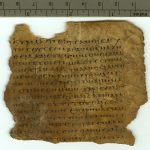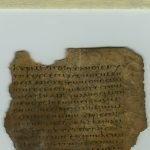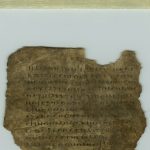| Artefact ID | 1558 |
| TM ID | TM 61655 |
| Findspot (DEChriM ID) | 23 (al-Šayḫ ʿIbāda) | Class | Textual |
| Material | Parchment |
| Writing medium | Codex |
| Text content | Literary |
| Language | Greek |
| Description | P.Ant. 1 12; Gregory-Aland 0232; van Haelst 555: Codex page fragment containing the Second Epistle of John (2 John 1-9) |
| Selection criteria | Literary genre (Biblical), Nomina sacra |
| Date from | 250 |
| Date to | 499 |
| Dating criteria | Palaeography. Letter sizes vary, and there is irregular spelling (possibly due to dictation?). In the ed.pr., Roberts compares the fragment to P. Lond. Lit. 192, P. Oxy. 4 656 and the Chester Beatty Codex of Daniel and Esther (all dated to the 3rd c.). Van Haelst 1976 agrees with this dating, but Cavallo/Maehler 1987 places it in the first half or middle of the 5th c. Kruger 2012 dates it to the late 4th to the 5th c., comparing it to Gregory-Aland 𝔓35. He further states that most miniature codices date to the fourth century or later, as does the use of parchment rather than papyrus. |
| Absolute/relative date | Relative date |
| Archaeological context | Excavations at al-Šayḫ ʿIbāda (Sheikh Abâda, ancient Antinoopolis), by John de Monins Johnson in Winter 1913/1914, funded by the Egypt Exploration Fund. |
| Accession number | Oxford, Sackler Library, Papyrology Rooms P. Ant. 12 |
ARTEFACT IDENTIFIERS
Editio princeps
• Roberts, Colin Henderson. 1950. The Antinoopolis Papyri. Part I. London: Egypt Exploration Society. 24-26, No. 12. Plate I.
Additional bibliography
• Aland, Kurt. 1994. Kurzgefasste Liste der Griechischen Handschriften des Neuen Testaments. Zweite, neubearbeitete und ergänzte Auflage. Berlin/New York: De Gruyter. 38, Majuskeln 0232.
• Aland, Kurt and Barbara Aland. 1981/1989. The Text of the New Testament. An Introduction to the Critical Editions and to the Theory and Practice of Modern Textual Criticism, transl. by Erroll F. Rhodes. Grand Rapids, MI: William B. Eerdmans. 104, 126, 160, 246. No. 0232.
• Barker, Don. 2009. “How Long and Old is the Codex of which P.Oxy. 1353 is a Leaf?” In Jewish and Christian Scripture as Artifact and Canon, edited by Craig A. Evans and H. Daniel Zacharias. Studies in Scripture in Early Judaism and Christianity 13 = Library of Second Temple Studies 70. London: T&T Clark. 192-202: 198.
• Cavallo, Guglielmo. 2005. Il Calamo e il Papiro: La Scrittura Greca Dall'Età Ellenistica ai Primi Secoli di Bisanzio. Papyrologica Florentina (Pap. Flor.) 36. Firenze: Edizioni Gonnelli. 187.
• Cavallo, Guglielmo and Herwig Maehler. 1987. Greek Bookhands of the Early Byzantine period: A.D. 300-800. London: University of London, Institute of Classical Studies. 20-23, No. 8c. Plate 8c.
• Comfort, Philip Wesley. 2019. The Text of the Earliest New Testament Greek Manuscripts. Papyri 75-139 and Uncials. Volume 2. Grand Rapids, MI: Kregel Academic. 263, 357. No. 0232.
• Kruger, Michael J. 2012. “The Date and Content of P. Antinoopolis 12 (0232).” New Testament Studies (NTS/New Test. Stud.) 58. 254-271.
• O’Connell, Elisabeth R. 2014. “John de Monins Johnson 1913/14 Egypt Exploration Fund expedition to Antinoupolis (Antinoë), with appendix of objects.” In Antinoupolis II. Scavi e Materiali, edited by Rosario Pintaudi. Firenze: Firenze University Press. 415-466: 440, Fig. 90-91.
• Orsini, Pasquale and Willy Clarysse. 2012. “Early New Testament Manuscripts and Their Dates. A Critique of Theological Palaeography.” Ephemerides Theologicae Lovanienses (Eph. Theol. Lov.) 88(4). 443-474: 472, No. 0232.
• van Haelst, Joseph. 1976. Catalogue des papyrus littéraires juifs et chrétiens. Paris: Publications de la Sorbonne. 195, No. 555.


 Json data
Json data





